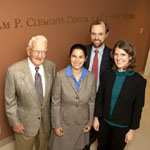Carolyn Barta: The depth of Bill Clements
The late former Gov. Bill Clements leaves an academic legacy that will serve generations.

Most Texans are familiar with Bill Clements’ political legacy as the state’s first Republican governor since Reconstruction. Those who were around in the 1980s remember his propensity for plaid sport coats, his outspoken, blunt talk. But few know of his love for Texas history and the impact of that.
As a Depression-era high school graduate making $150 a month in the South Texas oilfields, Clements sent $100 home to support his family and lived on $50. With every paycheck, he managed to buy a book — beginning a practice that would lead to a library of more than 8,000 volumes, including a huge collection of Texana.
His favorite books were histories, biographies and books about Texas and the Southwest. He credited Miss Willie Shook, a history teacher at Armstrong Elementary in Highland Park, with his interest; he later became a serious collector of rare books. By the early 1970s, his collection was valued at more than $1 million.
In 1971, Clements purchased and restored the Cumberland Hill School Building on Akard Street, the oldest public school in Dallas and oldest brick building downtown, to be headquarters for his worldwide oil drilling contracting company, SEDCO. After SEDCO was sold to Schlumberger in 1984, making him a millionaire many times over, Clements maintained an office in the building. It housed his personal “li-berry,” as he called it.
Clements wanted to share his passion for Texas and Southwestern history and in 1994 donated $10 million to establish the William P. Clements Center for Southwest Studies at Southern Methodist University. The funds provided for a new Ph.D. program, encouraged scholars of Southwestern history and culture and enabled many to publish their works. Among books published are those by Clements fellows and others for course use that resulted from symposia. Clements wanted to see educators trained who would pass along the unique history of the region to young people and future leaders.
Clements might brag about winning an election or knowing how to drill a hole in the ground, but he never bragged about the millions he gave to favorite philanthropies, which included huge gifts to UT Southwestern Medical Center and to his beloved SMU. He enjoyed making money, but said he enjoyed more giving it away.
Over the years, Clements and his wife, Rita, contributed more than $21 million for academic programs and facilities at SMU. He was instrumental in the development of SMU-in-Taos, donating more than $7.5 million for the university’s campus in northern New Mexico. His love affair with Taos dated to the late 1960s and SMU’s archeological efforts at the Pot Creek Pueblo. With his help, SMU began to acquire property in the area.
Today, a 295-acre campus is located 10 miles from Taos at Fort Burgwin, a pre-Civil War cavalry post — not far from the Clements’ summer casa. The Taos campus hosts undergraduate and graduate courses, research conferences and academic retreats and an annual colloquium lecture series that for 37 years has brought more than 40,000 people to free public lectures.
When most people think about Clements and SMU, they think of him as the person responsible for killing Mustang football after the pay-for-play scandal when he was chairman of the Board of Governors. This is not to excuse him for failing to take action before the NCAA did, although to his credit he had no knowledge of the pay scheme when he was asked to chair the board and stepped into a mess made by over-zealous alumni.
Rather, it is to say that the man who was laid to rest last week at 94 was far more complicated than the brash governor and political trailblazer most remember. He also leaves an educational legacy that has nothing to do with either football or politics.
# # #